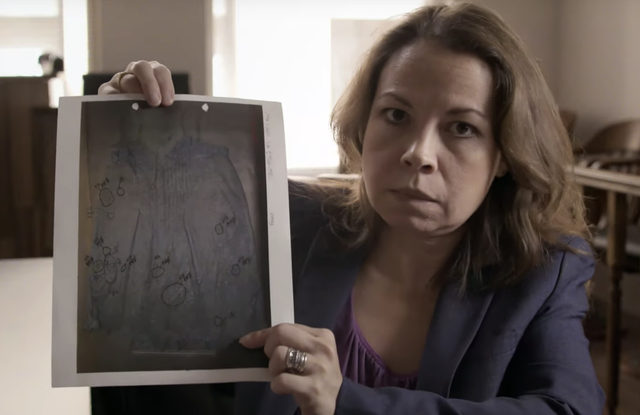

Review: 'Exhibit A' Is A Solid Sister Series To 'The Confession Tapes'
By Kristy Puchko | TV | July 2, 2019 |
By Kristy Puchko | TV | July 2, 2019 |

Beyond a reasonable doubt. That’s the idea. In the US, the prosecution in a criminal case must convince the jury of a suspect’s guilt beyond a reasonable doubt to achieve a conviction. With investigatory tools like video surveillance, blood spatter analysis, cadaver dogs, and DNA testing, it might be easier than ever before for the prosecution to find evidence that could lead to a conviction. And as crime-dramas and true-crime shows have been slinging lingo about these tools for years, everyone might think they’re a bit of an expert. But Netflix’s Exhibit A is here for a reality check. The new documentary series reveals how reasonable doubt can factor into even the most seemingly concrete forensic science.
Exhibit A has been created by Kelly Loudenberg, the director of Netflix’s The Confession Tapes. The two function as sister series, breaking down common misconceptions about seemingly silver bullet evidence. If you think a clunky confession, a blurry video, a single drop of blood, a barking dog, or a bit of DNA means someone is guilty beyond a responsible doubt, then Loudenberg has made this show for you. She’s setting out to demystify these investigatory tools with an eye to greater justice. Because as one interview subject explains, “If you have a science that is misunderstood, that science becomes like magic. And that’s what makes it very, very dangerous.”
Exhibit A explores four cases where a suspect was convicted on seemingly thin evidence. Season 1 begins with “Video-Forensic,” and the case of aspiring rapper George Powell, whose ambitions were put on hold when he was convicted for robbery, chiefly on video evidence. Eye witness testimony from the victims was ignored in favor of a grainy video and one expert’s conclusions. Now, at first glance, it looks easy enough to see that must be Powell on the tape. But this episode explores how looks can be deceiving and more specifically how the video must be questioned like any other witness.
Like with The Confession Tapes, Loudenberg interviews representatives for the prosecution and the defense. In this case, she offers contrasting opinions of the tape and the expert’s findings along with visual aids to show how video can be a shoddy witness. To me, the most striking example regarded frame rates, which is how many still-images are put into a second of video footage. Exhibit A shows a clip of a man, who appears to fire a gun twice. That’s how it’d seem in a low-frame-rate surveillance camera like you might find in a convenience store. Whereas the same incident shot on a camera with a higher frame rate might show six shots fired. With more pictures captured in that second, less information would be missing in between these frozen moments. It sounds obvious when spelled out. However, I used to work in video editing, and in all my years of watching true-crime shows, I never considered how frame rates might warp our perspective of such evidence. This left me drop-jawed. And the series offers several such mind-blowing moments.
Each episode of Exhibit A puts this critical lens to a different area of investigation. “Blood Spatter” unravels a 27-year-old cold case that heated up over an allegedly blood-spattered nightgown. “Touch DNA” explores the case of a brutal hate crime in New York City, where a discarded sneaker became the most crucial witness. While each episode has a tragedy within it, none hits as hard as “Cadaver Dogs.” In this episode, Loudenberg speaks with Banika Jones, the mother of Bianca Jones, a toddler who went missing in 2011. The child’s father, D’Andre Lane, said their daughter was abducted by an armed carjacker. The police called in cadaver dogs. Though no body was ever found, Lane was convicted for murdering Bianca. However, Jones believes Lane. She believes her daughter is still alive. And she’s not alone. But because the authorities don’t, she can’t depend on their resources to help her in her search.
Though Exhibit A presents both sides to a case, Loudenberg’s opinion comes through clearly. Through interviews with the convicted and their loved ones, she humanizes people who have been demonized in newspaper headlines. By offering visual aids and thoughtful metaphors on how these sciences aren’t as black-and-white in their findings as TV dramas would lead us to believe, she argues for those accused. She also gives space to their conspiracy theories and speculations. But while she’ll offer arguments for reasonable doubt, Loudenberg is not particularly interested in whodunit.
In one case, Exhibit A flashes a picture of a suspect, along with a stunningly terse explanation of the cause for suspicion and why he’s not been pursued. In “Cadaver Dogs,” she touches on what might have become of baby Bianca, but leaves us wondering what is being done to track this lead. We will be given no comforting closure. Instead, Loudenberg leaves us with the haunting words of the child’s devastated but determined mother. Over the course of the episode, Jones reveals to us who she is beyond her agony. She’s a strong, proud veteran, a cat lover, a homeowner, a baker, a defender of Lane, and a taker of no shit. She has a sharp wit and an even sharper turn of phrase. When asked if her daughter is dead as the police insist, she declares, “I can’t give up on my child’s life because a dog barked.”
Exhibit A is now on Netflix.
← The Official 2019 Pajiba 10 Hall of Fame | 'Euphoria' Recap, S1, E3: The One with the Dick Pic Tutorial and the Micropenis →
More Like This
One Of The Stars Of 'The Hangover' Is Joining 'Only Murders In The Building'
A Legendary Horror Franchise Is Headed To Television
Trying To Make it Through the Oscars
Josh Brolin Hosts 'SNL' but Ariana Grande and Scarlett Johansson Steal the Show
One Ruthless Move Saved an Otherwise Uneven Season of 'Traitors'

What’s Old Is New Again: Old Hollywood Glamour Glitters at the 2024 Oscars
Al Pacino Presents Best Picture Oscar, Confuses Everyone
The Dangerous Lie Of 'TradWives'
A Legendary Horror Franchise Is Headed To Television
'The Mandalorian' Season 4 Is Probably Not Happening
Halle Bailey On Why She Chose To Keep Her Pregnancy Private
More Like This
One Of The Stars Of 'The Hangover' Is Joining 'Only Murders In The Building'
A Legendary Horror Franchise Is Headed To Television
Trying To Make it Through the Oscars
Josh Brolin Hosts 'SNL' but Ariana Grande and Scarlett Johansson Steal the Show
One Ruthless Move Saved an Otherwise Uneven Season of 'Traitors'
Reviews